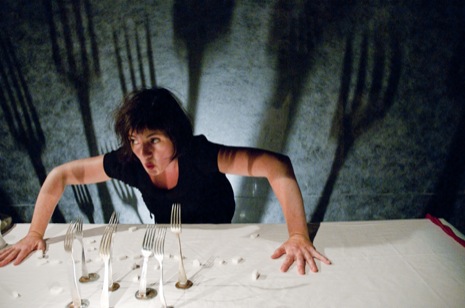What might a modern day fairy tale princess be like? Like a Barbie doll, with a ridiculously tiny waist and long legs, masses of yellow nylon hair, and smooth plastic where her vulva should be? Or maybe something a little more fleshy and earthy is called for?
Colette Garrigan might have a French-sounding name, live in France, and head up a French puppet and visual theatre company, but she was born and bred in Liverpool. Her contemporary princess is a Scouse wild child – a girl with a complicated relationship with her overloaded parents and a witch for a grandmother (nice shadow work with a broken off bread baguette forming the witch’s nose, and a quick bit of backcombing turning the performer’s black bob into a bird’s nest). This little princess does indeed prick her finger and fall into a deep sleep, just before her sixteenth birthday. Only the ‘needle’ is a syringe delivering heroin, not the spindle of a spinning wheel.
We start with Colette Garrigan close to the audience, addressing us directly. ‘Nice shoes’ she says to someone in the front row. ‘I once had some lovely ones, but I lost one…’ This is just one of many small witticisms making reference to iconic fairy-tale moments. Her tone is friendly and inviting, although she is speaking a little louder than she needs to in a room of this size.
Although Sleeping Beauty is a retelling of that particular tale, others get referenced along the way in the reflection on what it takes to make a princess. ‘Mirror, mirror on the wall – who is the fairest of them all?’ asks our heroine as she plays a teenager getting ready for an important date.
The stage is set with a long table bearing a white linen cloth and numerous objects that get brought into play – a toast rack makes a nifty handbag; forks become a forest. As you would expect of a Charleville-trained puppeteer, Garrigan is an excellent manipulator of objects and creator of visual imagery. The table is used extensively – play taking place above, around and upon it. A harrowing scene of our princess in a coma is played beautifully with the tablecloth becoming a hospital bedsheet, and then a puppetesque sleeping figure. Scale is played with as lights turn on and off and shadow figures and objects loom and recede – all this done by the performer who creates the onstage light and shadow play herself. To either side are lampshades that become miniature puppet stages. In one of many lovely moments, butterflies in the young princess’s stomach become shadow butterflies fluttering around a lampshade as she’s kissed by her first boyfriend.
This show has been touring many years, but is making its first appearance at the Edinburgh Fringe 2014. Faultless on the writing and on the visual aspects of the piece, Sleeping Beauty is performed with great gusto – but the performance feels a little forced at times. It feels like a show delivered by someone more comfortable generally with manipulating objects than with delivering words. This, though, could be partly due to the awkward mix of English and French employed – a worthy aim that doesn’t quite feel right. Although two ‘outside eyes’ are credited there is no listed director – and the piece feels that loss.
Despite some criticism of the performer’s vocal delivery, this is a gorgeous piece of visual theatre – and always good to see fairy tales given a modern twist. Take your daughters!
Sleeping Beauty is shortlisted for a Total Theatre Award 2014 in the Physical & Visual Performance category.

